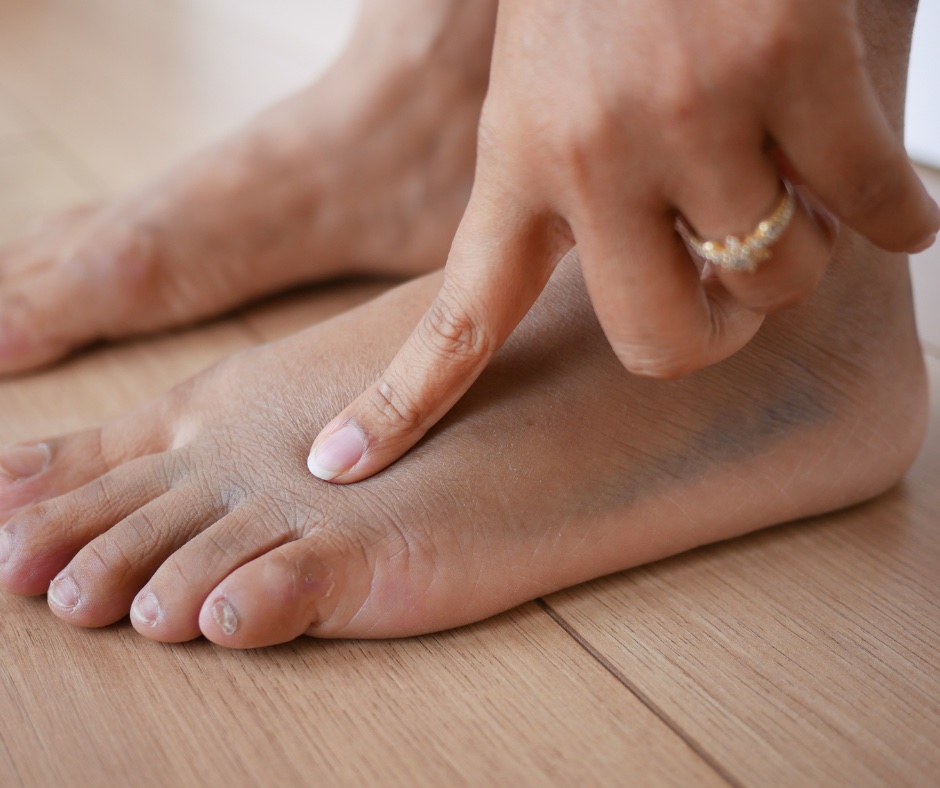Why regular footcare matters when you have diabetes
Over 1.3 million people live with diagnosed diabetes – and it’s estimated another 500,000 may have it without realising. That’s nearly 1 in 20 Australians at risk of diabetes-related complications, including serious foot problems.
Each year, more than 4,400 diabetes-related amputations are performed but most of these are preventable with early intervention and proper foot care. Your feet are often the first place diabetes shows complications – so looking after them should be a top priority.
What happens to your feet when you have diabetes?
Diabetes can affect your feet in two major ways:
1. Nerve damage (Peripheral Neuropathy)
Excess glucose in the bloodstream over time can damage nerves, causing numbness or altered sensation in the feet. This makes it easy to miss injuries like blisters, cuts, or ulcers until they worsen.
2. Poor circulation (Peripheral Arterial Disease)
Reduced blood flow to the feet slows healing and increases the risk of infection. Even small wounds can become serious if the body can’t repair the tissue effectively.
You may also notice structural changes in your feet, such as claw toes, bunions or collapsed arches, increasing your risk of pressure sores and ulcers.
Related blog:
Signs and symptoms to watch for
Early recognition is key to ongoing health. Here are some common warning signs of diabetic foot complications that should never be ignored:
- Numbness, tingling or burning sensations in the feet
- Loss of feeling in part or all of the foot
- Changes in skin colour (red, blue, or pale patches)
- Sores, cuts or ulcers that are slow to heal
- Swelling or warmth in one foot (may indicate infection)
- Cracks or dry skin, particularly around the heels
- Foul-smelling discharge from a wound
- Thickened, fungal, or ingrown toenails
- Pain when walking, especially in the calves or feet
- Foot deformities or changes in shape
If you notice any of the above symptoms, book an appointment with one of our experienced podiatrists as soon as possible as early treatment is vital to prevent further damage.
How our podiatrists help manage diabetic foot health
Our caring and professional podiatrists are trained to identify, treat and prevent the complications of diabetes before they become serious. At Sanders Podiatry, we provide routine diabetic foot checks and proactive management to reduce the risk of long-term issues.
Here’s how we help:
- Circulation and nerve assessments (neurovascular testing)
- Skin and nail care to prevent ingrown toenails and infections
- Wound monitoring and ulcer treatment
- Footwear recommendations to reduce pressure and friction
- Custom orthotics to help offload high-risk areas
- Patient education for at-home foot checks and hygiene
We also liaise with your GP, diabetes educator, or endocrinologist to ensure a comprehensive care plan is in place for your foot health.
Related blog:
Six footcare tips for diabetics
Managing your feet daily can dramatically reduce the chance of complications. Here are six practical, evidence-based tips you can implement straight away:
1. Check your feet daily
Use a mirror or ask for help to inspect your feet for blisters, redness, swelling, or broken skin. If you spot anything unusual – even a small cut – contact your podiatrist promptly.
2. Wash and dry carefully
Clean your feet with warm water and mild soap. Be sure to dry thoroughly, especially between the toes to avoid fungal infections.
3. Apply moisturiser (but avoid between toes)
Dry skin is more prone to cracking. Use a non-scented moisturiser on heels and soles, but skip the toe spaces to prevent fungal growth.
4. Wear proper footwear at all times
Protect your feet from injury by wearing shoes or slippers indoors and outdoors. Choose well-fitting, supportive footwear and avoid walking barefoot.
5. Trim nails carefully
Cut toenails straight across and file the edges to avoid ingrown nails. Don’t attempt to treat corns or calluses yourself – let a podiatrist take care of them.
6. See your podiatrist regularly
Even if your feet seem fine, it’s vital to have regular check-ups. We recommend at least one podiatry visit every 6 to 12 months, or more frequently if you’re at higher risk.
Give us a call and make an appointment – don’t wait for a problem to appear
When it comes to diabetic foot complications, early detection and regular podiatry care can mean the difference between a healthy foot and a serious health issue.
At Sanders Podiatry, we’re here to support you with expert diabetic footcare, tailored to your specific needs. From preventative check-ups to advanced treatment plans, our goal is to keep you mobile, healthy and pain-free.
Sander Podiatry Adelaide – 08 8379 1456 (Greenhill Podiatry)
